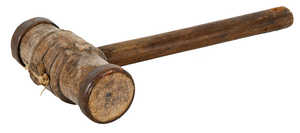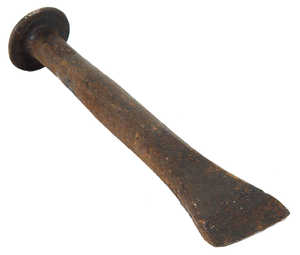Construction types. Clinker and carvel building
In this region, the characteristic clinker-built hulls of the
Eu-ropean Atlantic began to be replaced by flush-built hulls
in the period leading up to the Renaissance. The two building
techniques are conceptually opposed. Whereas in clinker
building, the outer planks of the hull are overlapped and an
internal structure added afterwards, in carvel building, a
technique which has survived to the present day, work begins
with the skeleton; this is then covered with planking which
is “carvelled” or joined together at the edges. There are
advantages and disadvantages to both techniques.
The main advantage of clinker is that freshly felled or green
timber can be used to build the hull, without requiring a
sealing process.
In carvel-built hulls, much more precise design of the shape
of the ship made it possible to optimise capacity. This feature
was particularly appealing for ships plying the new trading
routes to the Americas and Newfoundland.

Replica of a nineteenth-century fishing potina built by the
Albaola association. The construction of flush-laid hulls at Basque
shipyards was fully developed during the Renaissance period,
replacing clinker and lasting down to the present day. © José Lopez

Caulking tools; for inserting the oakum between the carvelled
planks. © José Lopez

Caulking tools; for inserting the oakum between the carvelled
planks. © José Lopez

Carvelling. It is important that the wood used to build a flushlaid
hull should be relatively dry. Before launching the boat, the
joins between the planks are filled with plant fibre; once it gets
wet, the wood will swell, ensuring that the hull remains watertight.
The smooth hull has the advantage of moving smoothly and
stealthily through the water. © José Lopez

Clinker-building. Because the strakes of the hull overlap, they
can be thinner, giving a lighter vessel. Moreover, green or recently
felled timber can be used. However, the relief on of the hull causes
turbulence during sailing, with a characteristic noise; as well as
affecting the hydrodynamics, the sound can betray the vessel’s
presence to potential prey, such as whales. © José Lopez

Model of the launch belonging to the Consulado of San
Sebastian. A clinker-built hull is easy to identify; the overlapping
strakes give her an outline which is recognisable from a distance.
Small official and military vessels were frequently kept on land and
were therefore often clinker-built, so that they could be launched
at any time without problems of watertightness. © José Lopez

The Urbieta wreck. This was an ore-carrying pinnace from the
second half of the fifteenth century, excavated in Gernika (Guernica).
The vessel, which was entirely clinker-built, comes from the
last period of the use of this technology which was completely replaced
by the carvel-built hull over the following century. © José Lopez

Cracking the plank along the grain in Aezkoa. © José Lopez

Scene from King Sancho the Strong's Pamplona Bible (1194).
(Harburg-Oettinghen Manuscript). The use of the axe by ship's
carpenters predated the use of the saw to make planks. Instead, the
logs were opened up by inserting wedges, first with the help of
mallets, to break up the logs and then cracking them along the
grain of the wood, with the axe. Finally they were smoothed out
with smaller hatchets. © José Lopez

Basque axe, made by the Erbiti family in Leitza, Navarre. © José Lopez














